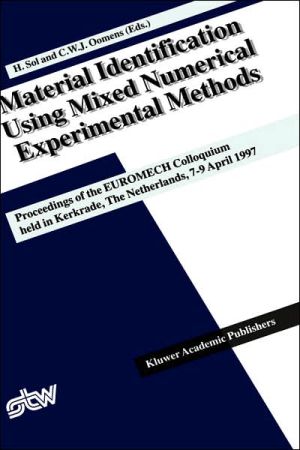Material Identification Using Mixed Numerical Experimental Methods
This book presents a selection of papers from the EUROMECH 357 Colloquium on Material Identification using Mixed Numerical Experimental Methods. For the first time, people from different scientific communities joined together in discussing methods for the mechanical characterisation of materials with which they work. The papers present a state-of-the-art overview of the methods and implementation for various applications. \ Starting from the measurement of output values (such as...
Search in google:
This book presents a selection of papers from the EUROMECH 357 Colloquium on Material Identification using Mixed Numerical Experimental Methods. For the first time, people from different scientific communities joined together in discussing methods for the mechanical characterisation of materials with which they work. The papers present a state-of-the-art overview of the methods and implementation for various applications. Starting from the measurement of output values (such as displacements, stresses, velocities, vibrations, etc.) of a real physical test structure, parameters in the numerical model are updated in such a way that computed observations match experimental observations. It is shown that the combined use of numerical analysing tools and sophisticated measurement techniques has created an extra degree of freedom for the design of experiments and has led to new approaches for material characterisation. The book is suitable for students at graduate level and beyond, and for researchers and professionals in the field of material characterisation, material processing and engineering. Booknews Twenty-nine contributions detail aspects of the latest advancements in methods of determining the values of unknown parameters in a numerical models by observations made on real physical test structures, which has allowed for greater freedom in experiment design and has allowed for new approaches for material characterization. Subjects include models of elasto-plasticity, material composites, concrete and soils, biological materials, and damaged materials. Annotation c. by Book News, Inc., Portland, Or.
Identification of the complex moduli of thin reinforced polymer plates using measured modal parameters1Characterization of interphase conditions in composite materials11Identification of shear-moduli of microstructures21Identification of the dynamic material properties of composite sandwich panels with a mixed numerical/experimental technique31Mixed numerical and experimental stiffness identification methods for soft textile composites41A simple method for determining the anisotropic properties of cold drawn wire51Analysis of inhomogeneous displacement fields for the identification of parameters for elasto-plastic deformation laws61Determination of Parameters in Elasto-Plastic Models of Aluminium71Material parameter identification for large deformation plasticity models81An inverse approach for the identification of complex material behaviours93Discussion on some estimators in mixed numerical/experimental techniques103Stochastic parameter identification in the case of data uncertainties109A combined numerical/experimental method for estimating parameters and structure of viscoelastic constitutive equations using complex flows123Computer aided identification of the temperature dependence of thermal properties133Complex material property identification for cement matrix composites by a mixed numerical-experimental method143Experiments and simulations of interface fracture in concrete153Inverse analysis of a tunnel excavation problem from displacement and pore water pressure measurements163Characterization of the in-plane mechanical behaviour of the human skin in vivo173Determination of trabecular bone tissue elastic properties by comparison of experimental and finite element results183Mixed numerical/experimental method for the identification of damage in composite materials193Inverse identification of the internal length scale of quasi-brittle materials using nonlocal damage models203Parameter identification of the cohesive crack model213Material property assessment in cracked reinforced concrete by dynamic system identification223Elastic moduli identification of a composite tube and an epoxy resin plate using both experimental and numerical modal analysis-sensibility analysis235Soil identification using data processing of penetration experiments236Complete elastic characterization of transversely isotropic composite rods by guided structural waves237Identification of material parameters for measurement error models via multiplier methods238Fibre/matrix interface fracture toughness identification in single fibre fragmentation test239A mixed numerical and experimental approach for the identification of elastic plastic relations in wide range of strains, strain-rates and temperature240








